How to enable disk check. Using the command line to restore your hard drive
If you have any problems with the hard drive, many immediately have a question about how to start chkdsk.
These problems can be very different - from banal braking, which is impossible to fix, to a complete failure to load the operating system.
The fact is that this is the best way to solve all possible problems with the HDD or even SSD. Most experts advise using it in such situations.
We will consider all really working methods that help to launch the recovery tool for the railway in Windows.
Method number 1. Using "Computer"
This option assumes that your system is at least somehow loading, that is, there is no complete refusal to boot. Yes, it can slow down, reboot spontaneously from time to time, and so on, but you can still, albeit with attempts, but still see the desktop and other elements of the system. If so, do this:
- Open Computer.
- On the main (system), and most often it is in C, right-click and select "Properties" in the drop-down menu.
- In the window that opens, go to the "Service" tab at the top. In the "Verification" section, click on "Perform verification ...".
- Next, a new window will appear, a smaller one. Check the boxes next to “Automatically fix system errors” and “Scan and repair bad sectors”. However, this can not be done, but it’s better to check these boxes, as you will not be able to fix all the errors yourself. Click the Start button.
After that, it remains only to wait until the tool performs its main task.
In some cases, after performing all the above operations, another window appears with the text: "Windows cannot check which is currently being used."
This means that some kind of error (next) has occurred, or you do not have access rights to certain files. In different versions of the operating system, this window may look different.
Without going into details, let’s say that it will be possible to press the “Yes” or “OK” button. So, you just need to do this and continue to calmly watch the recovery tool work.
Important! In some cases, you will need to restart your PC in order to continue. So if nothing happens after all the above steps, reboot your PC or laptop. It happens that the computer reboots automatically. This is not worth fearing.
Method number 2. Using the program execution window
In addition, the recovery tool in question can be launched using the standard execution of commands or programs, which is available in all versions of Windows.
Hint: To start the execution of programs, you can go to the "Start" menu and click "Run." You can also do this by simultaneously pressing the “Win” and “R” buttons.
- Enter the command in the following format: “chkdsk [drive letter]: / [command]”. That is, for example, to check C, you need to enter "chkdsk c: / f". It uses the one that fixes errors on the disk (“/ f”). In addition, you can enter the following parameters:
- / f - check and automatically fix errors;
- / i - lack of analysis of the so-called index parts (if you do not know what is meant, do not use this parameter);
- / v - along the way, display messages with scanned files (and their paths on the hard drive), as well as other messages about the progress of cleaning and analysis;
- / c - lack of loops inside folders (again, if you do not know what is meant by this, do not take it);
- / x - disconnect the drive before starting (the system will automatically check if there is a need for it and take the appropriate action);
- / r - search for “beaten” sectors and, of course, their automatic recovery;
- / l: [size] - to change the file size, the size must be specified in kilobytes.
In most cases, it comes down to entering a simple command “chkdsk c: / f” and clicking “OK”.
- After that, the verification process will begin. It looks like shown in figure №5. Here it remains only to wait until it is all over.
In newer versions, this process looks almost the same, but the interface is slightly different.
Again, after performing the above steps, another one may appear in which it will be indicated that the drive “cannot be locked”.
The meaning of this message comes down to the same thing as we said above - the disk is currently in use, which means that another failure has occurred or you do not have access to certain elements. In any case, it remains to enter the “Y” command and press the “Enter” button.
Important! To use both methods, you must have administrator rights on the computer. It is best to do this by opening cmd as administrator. In Windows 7 and below, there is a corresponding item in the Start menu - “Command Prompt (Administrator)”. In later versions, in order to see this option, you must click on the Start menu or the Windows menu. In the line that opens, enter "net user Admin / active: yes".
Method number 3. Using the Windows installation disc
In different versions, this happens in different ways. In the simplest version, even when the system boots from the installation file, several options appear, among which there is also the launch of the error correction program.
Here, for example, in Windows XP, you can simply press "R" and wait until the console starts. This is shown in Figure 8.
Hint: To see this menu, it is not enough just to insert a disk with the operating system, you still need to put the boot from it into the BIOS. How to do this, read the documentation for your PC. In the simplest case, you need to go to the "Boot" section and select the appropriate device near the inscription "1st Boot Device".
After the console is started, do the following:
Choose the version of the operating system that you will work with, that is, enter its number and press "Enter" on the keyboard. If you have only one OS installed on your computer, just type “1” and press “Enter”. In any case, the full list of systems installed on the PC will be listed below. In our example, there is only one OS, so we enter “1” and press “Enter”.
Then enter in the same format as we saw in the previous method, that is, “chkdsk [drive letter]: / [command]”. The list here is exactly the same. Therefore, enter this instruction, press "Enter" and observe the progress.
In this case, the program may require an administrator password. If you have one, enter it.
If not, then you either don’t know what it is all the same (since the program requires it), or it’s a glitch and you can just press “Enter” to continue.
In the first case, you will need to contact a person who was installing the operating system or someone else who can know this same password.
Thanks to this simple method, everyone can completely safely launch the hard disk checker and monitor its operation.
One of the above methods is clearly shown in the video below.
If you are looking for information on what chkdsk is, how to use it, it doesn’t work for you or it doesn’t work correctly, then here you are.
Introduction
If you are looking for how to download chkdsk for free, without waiting and SMS, without entering a number, I’m afraid to upset that chkdsk is by default present in every Windows system.
What is the ChkDsk program in general and why is it needed?
Let's figure it out (referring to Wikipedia).
CHKDSK (short for check disk) is a standard application in DOS and Microsoft Windows operating systems,
which checks the hard disk or diskette for file system errors (for example, the same sector is marked as belonging to two different files).
The CHKDSK utility can also fix file system errors found. Under Windows NT, Windows 2000, and
Windows XP, CHKDSK can also check the surface of the hard disk for the presence of physically bad sectors.
Found sectors are marked as damaged, and the system no longer tries to read from or write to these sectors.
Previously, [SCANDISK] performed this task. On a UNIX system, a similar command is called fsck.
By default, CHKDSK does not fix errors and does not check the surface of the disk for bad sectors.
But more on that later. Running CHKDSK takes some time — usually from a few minutes to several hours (depending on the hard drive, its size and occupancy).
Method 1. How to start Chkdsk from under Windows (for example, Windows 7 and Windows XP).
To begin with, running Chkdsk on Windows 7 is almost no different from running on Windows XP. The easiest way for the user to start the program is to go to the properties of the desired drive, for example, "C:", and go to the "Tools" tab. 
Next, click "Run Test" and the Chkdsk program window with a graphical interface will appear: 
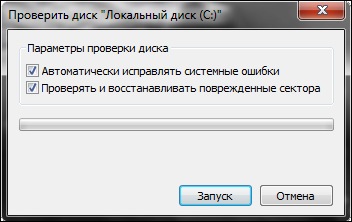
You can select scan options in the window. One is responsible for fixing errors on the disk, and the other - detects damaged sectors of the disk and restores them, and sets the error correction on the disk.
In case you are checking a Windows partition (for example, the "C:" drive), you may receive a message about the impossibility of verification. (on win-xp a slightly different plate, but with the same meaning):


This is normal and a check will be scheduled for the next run, i.e. will be made when the computer restarts.
If you select a different drive, then the check will occur from under Windows. P.S - In Windows 7 Service Pack 1, instead of the inscription OK, there may be an inscription "Schedule disk checks." This is so translated. The essence of the button remains the same.
Method 2. From the command line on the example of Windows XP
After failures, failure to turn off the computer, turn off the lights, etc. we can observe the following picture while loading the OS.
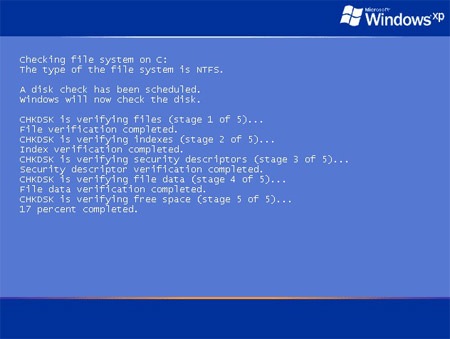
It means that a special program, Chkdsk, has been launched to search for and fix errors on the disk that may have occurred during the failure.
But there are also cases when there is an error on the disk, and Chkdsk did not start on its own. How to run it to fix errors on the disk?
To do this, go to the "Start - Run" menu.

And we enter a command with the following parameters [volume:], where: [volume:] is the letter of the disk (partition); is the parameter that sets the error correction on the disk. The following command will be received: chkdsk with: / f
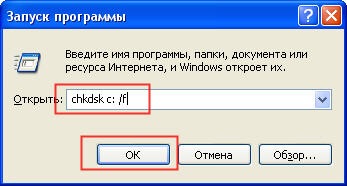
In my case, the drive is "C:". Accordingly, if you need to check another disk, for example, "D:", then specify: "chkdsk d: / f" To check, the disk must be locked, so after running the command using the OK button, the following window may appear, in which it says:

"It is not possible to execute the Chkdsk command because the indicated volume is being used by another process. Should I check this volume at the next system reboot?
[Y (yes) / N (no)] "Press the Latin letter Y and Enter on the keyboard, and now during the next boot of the computer, the chkds k command will check the specified disk for errors and fix them.
After the reboot, the following window will be displayed:

It should also be added that the / f option is not the only option to the chkdsk command. There are others, but they are rarely used.
On the site you can also find all the descriptions of the keys (parameters) of the command.
Their description is also presented below. The only option that may come in handy is the / r option, which detects bad sectors of the disk and restores the part of the data that can still be read. A command with this parameter will look like this: chkdsk c: / r To achieve the effect, you must have administrator rights (!).
Method 3. How to start Chkdsk if Windows cannot boot?
Imagine, one fine day, you are sitting at a computer when suddenly a power surge is small, but the traffic jams are knocked out. Your computer, hiccuping, turned off abruptly. Having adjusted the light, you turn it on, but after all, bad luck, Windows does not boot! One of the options is that there was a failure on the main hard drive, which prevents the bootloader from working normally. How to fix it? "How to start Chkdsk if Windows cannot boot?" - You ask. I will try to explain everything to you in this article.
First you need to insert your installation disk, before loading Windows, into the drive. This message appears:

* - On different computers the BIOS "a settings are different, so your disk will boot automatically, or you will need to press a key (the most common one is f12 or Del). Which key to press should be written as soon as your computer turns on.
We press any key, the process of preparation for installation begins. After that, you will see the following:
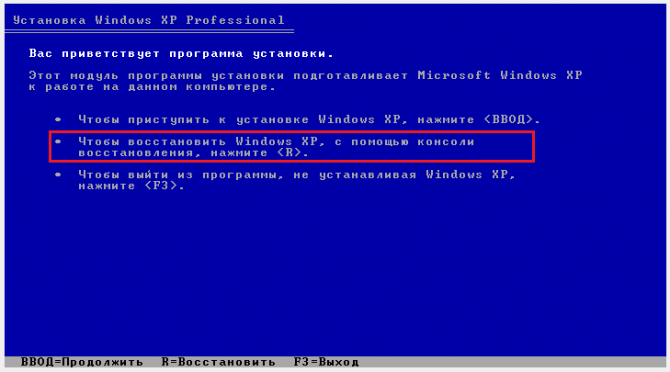
Press [R] and go to the recovery console. From the list, select the item with your copy of Windows (I have only one - No. 1.)
If the administrator has a password (the most important hidden account in XP), you will be asked to enter it (In my case, it is and I entered it):
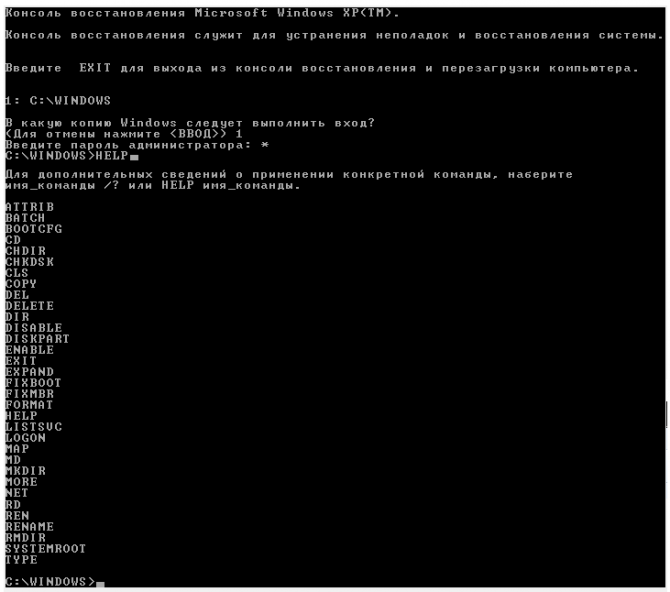
There is an opportunity to enter commands. Hooray. Let's not rush, enter the word HELP. A list of commands appears. Now we only need the CHKDSK team.
Entering parameters is optional. If you need to perform not the most effective check in a short time, then boldly type "CHKDSK" and press Enter.
But if you need an effective check (though for a long time), then do not be too lazy to read to the end! So, let's see all the parameters of this command before entering it.
To do this, we enter the command "CHKDSK /?" Or "HELP CHKDSK" first.

As you can see, in the picture, the / R parameter includes the responsibilities of the / P parameter, so we will not consider / P.
Okay, let's not get too distracted and continue. After you more or less figured out the help of the team, we can begin to practice.
Enter the command CHKDSK [drive:]. For example, "CHKDSK C: / R". If you have only one hard drive, then [drive:] can be omitted (undesirable).

Everything! The verification and recovery process has started! We are waiting, drinking tea and rejoice.
Console Commands:
Command: CHKDSK [volume:] checks the specified disk using the Check Disk program; when called without arguments, the current disk is checked.
Drive into the console without brackets. Example: C: / F / R
- volume - defines the volume label of the disk being checked, the connection point or the name of the disk with a colon (for example, C :);
- path, file name - the name of the file or group of files to check for fragmentation. Used only in the FAT / FAT32 file system;
- / F - check for errors and their automatic correction;
- / V - during the disk scan, display the full paths and names of files stored on the disk. For discs containing NTFS partitions, cleanup messages are also displayed;
- / R - search for bad sectors and restore their contents. Requires mandatory use of the / F key;
- / X - if necessary, disconnect the volume before checking it. After disconnection, all current descriptors for this volume will be invalid. Requires mandatory use of the / F key;
- / I - do not conduct strict checks on index elements. Used only in the NTFS file system;
- / C - do not check for loops inside the folder structure. Used only in the NTFS file system.
- / L: size - during the check, change the size of the log file to the specified value (in kilobytes). If no value is specified, the current file size is displayed. Used only in the NTFS file system;
Developer errors in CHKDSK (!):
- The interface of this wizard may be available only in English, however, automatic correction can be performed in other language versions of Windows.
- If the download is not from the computer on which the problem is detected, you can save the automatic fix to a flash drive or CD to run it on the desired computer.
How to force remove restore CHKDSK from startup?
Foreword:
Let's dot all the i and try not only to solve the problem point by point, but also to understand its essence (so as not to step on the same rake in the future).
And the problem is the following: A disk check comes out every time the system boots. I can’t name the reason for sure, since this problem has several.
Most likely - your hard drive is slowly dying, or it just crashed the system. The fact is that when you turn on the computer, its kernel is loaded first, and then the system itself.
So, with each kernel boot, the Autochk.exe program is called, which checks the hard drives for the “Dirty bit” mark (see Wikipedia).
If such a mark is present, then Autochk.exe runs the chkdsk / f command, which runs for the marked volume.
So is it possible to force chkdsk to be completely disabled from the so-called autorun at all? I will answer you, yes. This can be done as follows.
I want to warn you right now that disabling CHKDSK autorun deprives you of control over the integrity of your file system, which can lead to consequences!
1. First you need to start the registry editor. Standard way:



3. Find “BootExecute” and erase its contents.
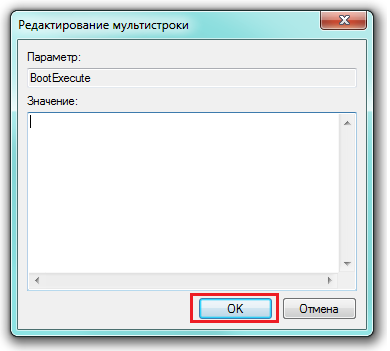
Autocheck autochk *
Method 2. Softer shutdown
1. Go to RegEdit
2. We go again to the section
HKEY_LOCAL_MACHINE \\ SYSTEM \\ CurrentControlSet \\ Control \\ Session Manager
3. To your autocheck autochk * entry in the BootExecute parameter, before the * sign, add “/ k: C” without quotes. Where C: is the letter of your drive for which you want to disable verification. It should now look like this: autocheck autochk / k: C *.
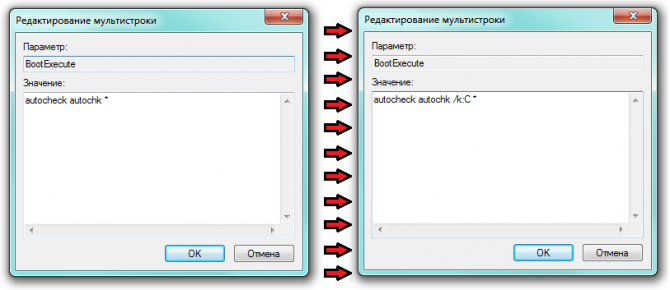
If you have several volumes, separated by spaces, add the required number of entries “/ k: C”, where C is the desired letter of the volume. For example: autocheck autochk / k: C / k: D / k: E *.

That is, I turned off the automatic CHKDSK check for volumes C :, D :, and E :.
How to get everything back?
1. Go to RegEdit
2. We go again to the section
HKEY_LOCAL_MACHINE \\ SYSTEM \\ CurrentControlSet \\ Control \\ Session Manager
3. In the BootExecute parameter, we erase everything that was and write:
Autocheck autochk *
or what was originally there. It is assumed that this was the record before you even got there. If you have a saved copy of the original record that I wrote about in the first method, then write it.
How long does it take Windows to boot? Sometimes it seems like it takes an eternity. There are several methods to speed up system loading, but perhaps the problem is that your computer performs the CHKDSK function at each boot.
Did you notice the filling bar while you were waiting? Does she appear often? Have you ever wanted to know what it is, what is happening, and does Windows really need to do this? Read this article and we will answer all these questions together.
If you are not sure which drive you have installed, check if it is a solid state drive ( SSD) or hard disk ( HDD) If your computer has an SSD, you can still use Check Disk, but you do not have to run a check with the flag / r. There are some differences between SSD and HDD, in particular, SSD does not have moving parts.
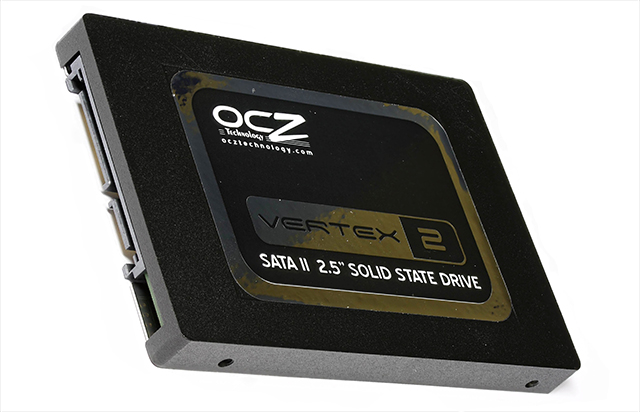
The SSD does not include a physical disk, so it does not need to be checked with the chkdsk c: / r command. However, Windows uses the same file system on both the SSD and the HDD, so you can fix file system errors using chkdsk c: / f. Other than this, Check Disk is not necessary.
On Windows 7 and earlier, verification may take some time. Maybe an hour, and sometimes an entire day or more, so make sure you have some free time. Do not interrupt the operation of Check Disk after it has begun.
To start the utility, click on the Start button. In the search bar, enter " command line". It should appear in the search results. Right-click on the command line and select "".

After the command prompt window appears on the screen, enter the command
and press the button Enter. Thanks to the / r flag, the program will try to recover information from the damaged sectors, as well as fix all errors on the disk, so you do not need the / f flag.
The command line will tell you that it cannot perform this action because the indicated volume is currently in use. She then asks if you want to schedule a volume check for the next boot. Enter Y and press Enterto schedule the launch of Check Disk with the error correction option.

Restart your computer and wait for the utility to complete its work. After the check is completed, all errors must be fixed, and Check Disk will no longer start at boot, unless, of course, there are other problems.
Windows 8 deals with such problems in a more efficient way. The file system constantly checks itself for errors. Errors that do not require a disk shutdown are fixed immediately. Correction of other errors, which can be performed only at boot, is planned for the next system startup.
Since the system needs to fix only those errors that require a disk shutdown, Check Disk does its job in a few seconds or minutes. To do this, click Start. Enter “ cmd»To the search bar of programs and files. The topmost search result will be cmd.exe. Right-click on the line and select “ Run as administrator».

To make sure that all other problems are found and resolved, first run a disk check by running the command
chkdsk C: / scan
and by pressing Enter. During the scan, the utility will fix everything that does not require a disk disconnect. After verification is complete, enter the command
chkdsk C: / spotfix
and press Enter. You will see a text saying that this volume is busy with another process. The command line will then ask if you want to schedule a disk check for the next system boot. Enter Y and press Enterto schedule Check Disk to run. Now restart your computer.
This time, Check Disk will start and fix all errors detected during the scan. And since the utility only has to fix errors that require a disk shutdown, it will take only a few seconds or minutes.

Your file system should now be fine. Check Disk will no longer start when you turn on the computer, if there are no other problems.
Check if it helped
After completing the work of Check Disk, there is only one way to check whether the utility has completed its task - restarting the computer. Let's hope that the program will no longer start, and you can continue your work. If Check Disk continues to run, you may have more serious problems with the file system, or errors related to the registry or the operating system itself. You should consider restoring your system or reinstalling Windows completely. Maybe it's time to change the hard drive. Of course, this is an extreme measure, but it definitely solved your problems.
Did this article help you fix your problems? Did you find other ways to stop Check Disk from starting at every boot? Maybe you have some questions? Share them in the comments and we can help each other.
Good day! I already talked about, and in my articles. In this post we will talk with you what the Chkdsk team means. This command also optimizes your PC, monitors the security of important system files and makes it stable.
Using this method, we will correct system errors and analyze disks for errors. Just for such purposes, the Chkdsk program is also used.
Chkdsk Check for Disk Errors
Most PC users still do not use devices for uninterrupted computer power, so they may suddenly turn off the power supply. Among other things, computers often experience various crashes.
How to run the Chkdsk program; how to run to fix disk errors
If you notice that your PC has often become buggy, started for a long time, or even you have a blue screen of death, but this program does not start, you can start it yourself and check your OS for errors. There are a couple of methods for this.
Chkdsk how to run graphically
First, apply the graphical method. To do this, click on the “Computer” tab, select the required drive (in most cases, C) and apply the context menu (for this, click the right mouse button), go to “Properties”. Then click on the item "Service". Here we select the "Run Test" key.
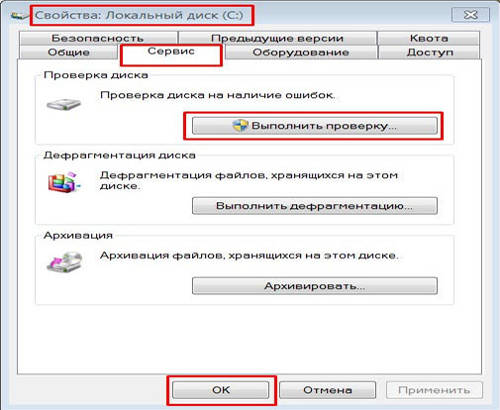

If we check the drive where our system is installed, this check will be performed during the reboot of the PC.
- If we just want to carry out a check and at the same time not correct errors, if they are found, remove both checkmarks and click on the “Run” button.
- If we want the sector check to start immediately, we’ll select the bottom line and remove the checkmark above the top. Otherwise, we will get a message that the system disk is working now and the scan cannot begin.
- If you want to find errors and correct them, put a check in the first line.
- If you need to conduct an analysis of systemic and physical. mistakes and you have a desire to correct these errors, you need to put both daws.
- If you want to carry out verification and correct errors, you need both daws.
Chkdsk how to run through the command line at boot
We need to enter the command line chkdsk with: and do not forget to press "Enter", while the system will only check the disk for errors, but will not fix them, C is the name of the disk. If we need not only to analyze, but to correct errors, after the name of the disk enter / f , eg, chkdsk f: / f
If you are checking the system drive, they may indicate that it cannot be verified, because It is now in use and will be asked if it needs to be checked at reboot? Press Y if you need it and N if not.
Also, the “Computer Accelerator” program allows you to check the disk for errors. This program not only checks the disk for errors, but also cleans the system, registry and more. Download program can link, or simply by clicking on the banner:
The chkdsk command should not be used often; it is advisable to use it in case of serious problems to restore the OS and the hard drive to work properly. I advise you to apply no more than once every three months! Good luck! How to start the Chkdsk Windows utility to fix file system corruption you now know and would be closer to the smooth operation of the system!
Video how to run Chkdsk
Joke in each article:
Chkdsk is a utility program designed to check the hard disk for errors and fix them. The program is used in cases where the system displays messages about various errors related to the hard disk, files, drivers, etc.
In order to run this utility in Windows 8, you need to do the following:
Step 1. If you are working with the console from a user account, then when you enter the CHKDSK command, this window will appear:
The easiest way out is to switch to an account admin and run the console as administrator. We go to the Start menu and select a user with administrator rights:

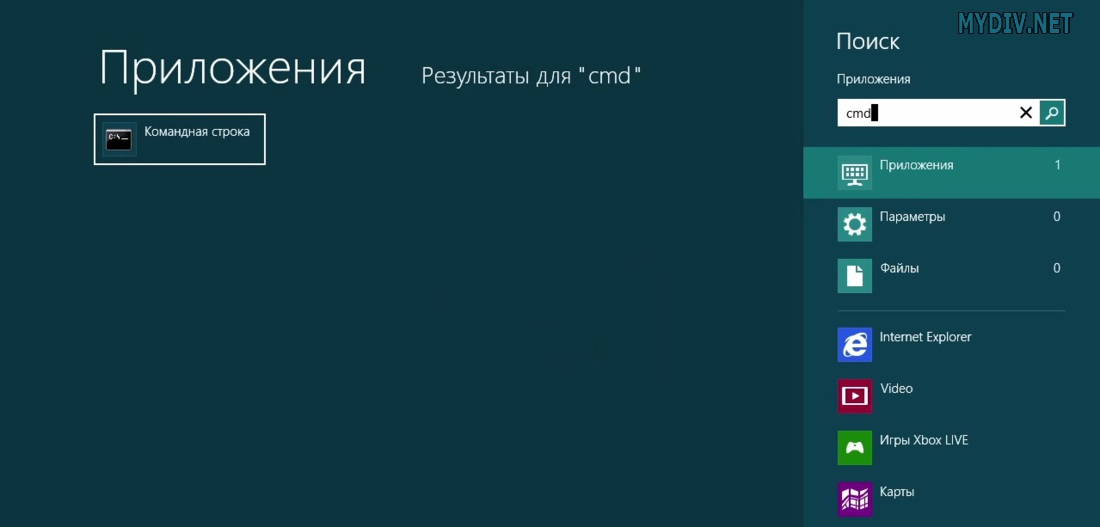
We click on this application with the right mouse button. An action panel will appear below: select "Run as administrator":

We will launch the console as administrator:

Here we need to enter the chkdsk command and press the Enter key, after which the disk check will start.
If you do not have the opportunity to do this, or you do not know the passwords from other people's records, you will have to check each logical drive separately. To do this, go to "My Computer" and select the desired drive:

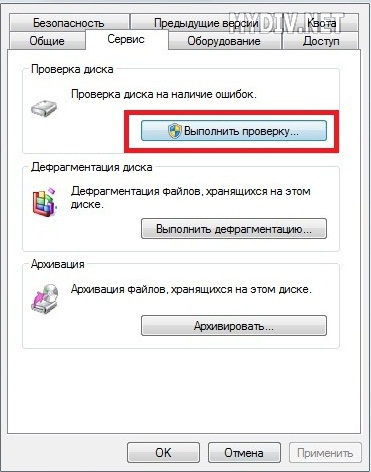
We put all the checkmarks and click "Launch":
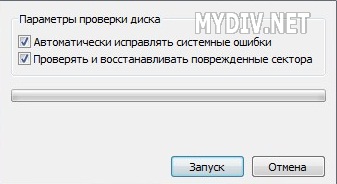
We will be asked to reboot the system, after which this disk will be checked.
Step 2. If you know for sure that you are working under an administrator account, simply press the key combination Win + R on the keyboard. In the window that appears, type the command “cmd” without quotes. 
Step 2 Now write the command “chkdsk” without quotes, as shown in the screenshot. The program will search for errors (without fixing them). How to fix found errors is described below. 
Step 3 Add the /? Flag to the command, as shown in the screenshot. All parameters of the chkdsk utility will be displayed. Select an option. In particular, to correct errors, use the / F option.


